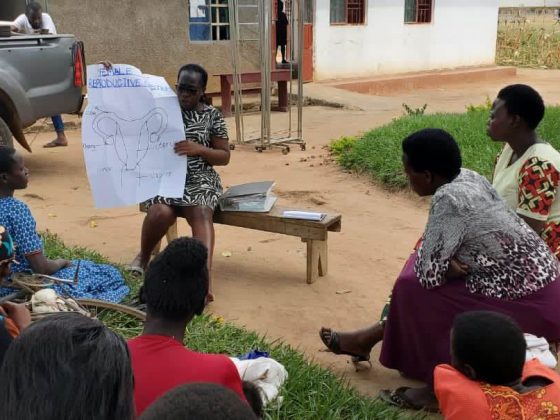This investigation was prompted by the story of Julia, a lawyer who fled her home in Kyiv in the spring of 2022, as Russian forces were advancing on Ukraine’s capital. At the time, the mother of two was reaching the end of a course of neoadjuvant treatment for breast cancer, which she had been prescribed as part of her treatment plan, which included breast conserving surgery to be followed by chemo and radiotherapy. Confident in the Polish government’s generous commitment to cover the healthcare needs of refugees like her, she was set to proceed with the surgery, but to her dismay she found that the only option open to her was a full mastectomy. She returned to a country at war, where cancer services were struggling to keep functioning, to get the treatment she wanted.
“It was one of the most difficult choices of my life. It was very unsafe to return to Ukraine. But I couldn’t imagine my life without a breast,” Julia recalled in an interview with Cancerworld.
My editor was surprised at this decision. As a former breast cancer patient from Warsaw, I was not.
A full mastectomy was all that I was offered on being diagnosed in 2017, when I was 32 years old. The surgeon who had been recommended to me insisted it was the only solution. “Unfortunately, you have the bad luck to be breastfeeding your child, there is no other option. Don’t worry, I will somehow reconstruct this breast for you later,” he said in an authoritative tone.
Bad luck of breastfeeding?!
I was reading my child the popular Polish rhyme about a frog that went to the not-so-clever doctor, when the first doubts about this advice crept in. It goes like this:
“The frog was cured and cured,
and it dried and it dried,
Until it got so dry that a little by little
A handful of powder remained.”
I didn’t want a ‘handful of powder’ to be left from my breast, so I started looking for information on the internet about breast surgery and contraindications to breast conserving surgery. I also went to another doctor for a second opinion, and to a third – the supervisor of ‘my’ surgeon. Everything I read and heard confirmed that lactation is not a contraindication to breast conserving surgery.
When I took this information back to my first surgeon, together with the second opinions – including from his supervisor – he continued trying to convince me to proceed with a mastectomy, saying that “the breast during lactation heals badly, and in general there will be only problems.”
We did not meet again. I went to another surgeon for breast conserving surgery. The breast healed quickly and well, without problems. Except for a small scar, I have no trace of the disease. For me, this means I feel I can live my life as before. I can wear what I want, I can go to the beach and act like any other healthy person. This chance to save my breast changed my perception of breast cancer in general, and I feel it kept my life on course.
Today I know that I am one of the lucky ones – maybe not just luck but a combination of luck and determination.
I speak with Ewa (not her real name) shortly before her 38th birthday. She had been diagnosed with triple-negative breast cancer a year earlier, and was treated at a centre in eastern Poland. The first treatment planning offered her breast conserving surgery with prior neoadjuvant chemotherapy. While waiting for treatment to start, however, new tumours were detected in her breast, and later a genetic mutation was detected, and she was advised she would need a full mastectomy.
But when Ewa asked about breast reconstruction, she was told that was not an option. “I asked why. I heard that it was because there would be radiation therapy later, and in such cases reconstruction is not practised,” Ewa recalls.
At the next visit she asks again about immediate reconstruction. In response, she hears only one word “no”.
That sense of unfairness hits her every time she looks in the mirror or has to wear a high-collar top to hide the lack of her breast
“I was anxious to be out of surgery so that the cancer would be gone. Now when I read that reconstruction surgery can be done despite the radiation therapy, I am very angry. I think the patient should have the choice.”
The worst thing about it, says Ewa, is the feeling that, had she been treated somewhere else, she could have got the treatment option she wanted. “I have big breasts, I mean I had, because now I only have one. They were very nice. It’s hard for me now.” That sense of unfairness hits her every time she looks in the mirror or has to wear a turtleneck or high-collar top to hide the lack of her breast.
European quality assurance schemes, policies and laws
The requirement for breast cancer units to pay attention to aesthetic outcomes, and discuss all options with patients, has been the focus of intense patient advocacy in Europe and the US for three decades, and is enshrined in some policies.
The 2003 European Parliament Resolution on breast cancer, clause 7c, calls on member states to “protect the psychological well-being and physical integrity of women by ensuring that, wherever possible, breast reconstruction operations are performed… within the shortest possible time,” noting that, “This procedure largely reflects patient demand and should be a key consideration in the multidisciplinary management of breast cancer.”
The resolution also calls for all patients to be treated within ‘certified’ multidisciplinary breast centres, as a way to harmonise standards across Europe, including on access to breast conserving and reconstructive surgery. These standards are set out in the Requirements of a Specialist Breast Centre, which have been specified by the European Society of Breast Cancer Specialists, EUSOMA, since 2000, currently include the requirement that breast surgeons must have “expertise in breast surgery including oncoplastic procedures,” or failing that, “in some centres this role may be shared by a breast cancer surgeon and a reconstructive surgeon working together.”
As breast surgeon Isabel Teresa Rubio, currently President of both EUSOMA and the European Society of Surgical Oncology, explains, the requirements regarding the capacity to protect the aesthetic outcomes of breast surgeries is backed up by quality indicators, that breast units need to comply with to be certified as a Specialist Breast Centre through the European voluntary accreditation scheme. These include minimum and target rates of breast conserving surgery in eligible patients, and minimum rates of reconstruction in the case of mastectomy.
One of the Requirements of a Specialist Breast Centre is for the breast surgeons to have expertise in oncoplastic procedures
Data collected from 51 certified breast centres that are part of the EUSOMA network, says Rubio, show that, in practice, only around 30% of patients undergo mastectomy, and that, among those, reconstruction is performed in more than 60% of cases.
It is notable, however, that, so far, applications for certification through the EUSOMA quality assurance have come almost entirely from certain western/southern European countries. Currently no breast units in central or eastern Europe feature among the 51 certified through this scheme, though the Bialystok Cancer Centre in eastern Poland is in the process of applying – the first in the region to do so.
Nor do countries in central/eastern Europe have the sort of national quality assurance schemes for breast units that run, for instance, in Germany the UK and Switzerland. Early steps to standardise the quality of breast cancer have been taken in Poland. A government decree that came into force at the end of 2019 sets out national requirements for a treatment centre to be designated a Breast Cancer Unit, which seem to be based on the EUSOMA requirements. These include having a multidisciplinary team specialised in treating breast cancer, minimum caseloads for diagnostics and treatments, and that breast units should have surgeons with skills in oncoplasty and reconstrutction. The requirements also specify that treatment protocols should be based on the guidelines. These include that women should be offered breast sparing surgery wherever possible. A long list of designated ‘Breast Cancer Units’ is publicly available on the Internet.
The only problem, as Tadeusz Pieńkowski points out in the document, ‘Audit of Breast Cancer Treatment 2010-2020’, is that no accreditation process was established – there is no indipendent structure charged with checking whether treatment centres comply with the requirements.
As a result, it is impossible to know which centres deliver high quality care and which to avoid, or to get reliable data on differences between countries. Despite my repeated requests for data on the rates of breast conserving surgery, and rates of reconstruction for those undergoing mastectomy, no hospital provided that information.
The National Health Fund, which pays for the procedures, told me it does not gather that data, though in response to my request, they made an effort to compile such data as they do have.
These show that, in 2022, 17,407 ‘complex breast procedures’ were performed. Of these, 3,660 were breast-conserving surgeries (21%), and 3,176 mastectomies with simultaneous reconstruction (18%). There were also 2,549 delayed reconstructions (15%). That would seem to leave almost half of the complex breast procedures (more than 8,000) unaccounted for. Despite persistent requests, so far no one in authority has been able to clarify what these procedures were.
A problem of late diagnosis?
While caution is needed when speculating over inadequate data sets, the impression of low rates of breast conserving surgeries and of reconstructive surgery at or after mastectomy does seem to be borne out by the experience of patients and professionals.
Speaking specifically to the rates of breast conserving surgeries, National Health Fund spokesman Andrzej Troszyński points out that these are likely to be affected by relatively low take-up rates within the national mammography service, which offers free screening once every two years to all women between the ages of 50 and 69. “Some patients may come to the oncologist with more advanced disease, which can also have an impact on later surgical treatment,” he says. He cites a take-up rate of only 36%, which would certainly be at the lower end of participation rates across Europe published by eurostat – though a more complete dataset for Poland, cited in a 2023 study, found that more than 53% of women aged 50–69 had been screened sometime over the previous two years, which is average for Europe as a whole.
Data on stage of diagnosis does, however, point to significant differences compared with western Europe. The most recent data published by the OECD, which relate to the period 2010–2014, shows rates of early diagnosis in Poland at 41% – a full 10 percentage points lower than the OECD average at that time (51%). Rubio estimates that, currently in western Europe, “60%–80% of newly diagnosed cancers are amenable to breast conservation (wide local excision and radiation therapy), at diagnosis or after neoadjuvant treatment.”
A problem of ‘eminence-based‘ medicine?
Ewelina Patała works with the breast cancer patient advocate organisation OmeaLife Foundation, and runs the Facebook group ‘Breast surgery – I care about it’. She believes a large part of the problem is that too often patients are not given accurate information about the risks and benefits of different options, and they are railroaded into decisions that they later regret.
“This is still due to [the surgeon’s] personal beliefs that mastectomy, i.e. more radical treatment, will be more effective,” says Patała “Often female patients also think this way, fearing the lack of radicality of the treatment or the recurrence of the disease. Ideally, decisions should be based on current medical knowledge and not based on beliefs or emotions,” she says.
EUSOMA President, Rubio, agrees. “Breast conserving surgery is the primary surgical choice for breast cancer,” she affirms. Not only is it associated with lower complication rates and a better quality of life than mastectomy, she says, but “some recent studies have even shown that patients treated with breast conserving surgery had better overall survival rates than those treated with a mastectomy.”
“If breast conserving treatment is possible, it should be offered, including in an oncoplastic form, to keep the breast in the best possible shape”
Her message is echoed by Radosław Tarkowski, a cancer surgeon who has worked for 20 years at the First Department of Oncological Surgery at the Lower Silesian Oncology Centre (serving a region in the south west, bordering on Czechia) and the Department of Oncology at the Medical University of Wrocław. In the absence of evidence-based contraindications, he says, “there is no advantage of mastectomy over breast conserving surgery.”
“So long as breast conserving treatment is possible, it should be offered,” he adds, “Not only in the simplest form, but also in an oncoplastic form, to keep the breast in the best possible shape.” Tarkowski has learnt from experience that, at the time of diagnosis, and even a year or two after treatment, patients tend to focus primarily on the stress associated with the disease, but as that stress recedes, they start to feel more bothered by the hollow in their chest, or asymmetry of their breasts.
A full discussion of the surgical options is essential, he emphasises. “It is a matter of giving the patient proper information. A conversation with the patient is crucial because surgery starts with words.”
A problem of capacity?
Tarkowski points to a lack of the requisite surgical skills as a key factor behind the poor rates of breast conserving and reconstructive procedures. “It happens that patients end up in some unprepared hospitals that have no experience in treatment of women with breast cancer. Surgeons who work there operate cancer patients once or twice a year, and this should not be acceptable,” he says.
“These are no longer the days of ‘Dr. Quinn’. If one treats a specific group of patients, then one becomes better and better at treating that particular group. When I needed knee surgery, I went to the best surgeon who specialises in knee surgery. It’s the same with breasts.”
“Where conserving surgery can be performed, these operations tend to be performed”
Dawid Murawa, another experienced cancer surgeon who heads up the Clinical Department of General and Oncologic Surgery at the University Hospital in Zielona Gora, in the west of the country, agrees that the problem is primarily around the lack of specialist skills.
I speak with him moments after he returns from the operating room, where he conducted a mastectomy with reconstruction, using an implant and synthetic mesh. Funding for such operations used to be an issue, he says, but that is no longer the case. “A few years ago, the pricing of the procedure was four times lower than in Germany. Today, this difference has been halved.”
“Where conserving surgery can be performed, these operations tend to be performed,” says Murawa, who is a provincial consultant for oncologic surgery for the whole region. He points to the average age of surgeons in Poland, which is now over 60. “A few years ago it was 58, the average age is steadily increasing. This is reflected in treatment options.”
Patała recognises that picture from her experiences listening to patients’ stories and advising them on how to find the treatment they want.
“The issue is due to the still insufficient number of oncological surgeons specialising in breast surgery and the limited time available in operating rooms,” says. “Performing mastectomies with simultaneous reconstruction, deferred breast reconstructions or adjustments requires time. Time constraints and staff shortages, combined with the large number of patients in the centre, result in a lack of access to all the options modern surgery offers us.”
“The fact that the hospital is a large reference centre doesn’t mean that the patient will be offered the full range of options,” she adds.
The experience of Kamila (not her real name) is a case in point. A resident of Szczecin, a large voivodeship city in north west Poland, she developed breast cancer at the age of 45. Doctors offered her a full mastectomy only. Immediate reconstruction was an option, they said, but such surgeries were not performed in Szczecin. She would have to travel almost 400 kilometres south to Walbrzych – “[That’s] almost the other end of the country!”
“If I had belonged then to the Facebook groups I belong to now, I would not have decided so quickly to have this radical mastectomy”
“I chose Szczecin. It was closer, I was in a difficult moment mentally, I didn’t have the proper knowledge at the time, I couldn’t imagine the consequences. If I had belonged then to the Facebook groups I belong to now, if I had had the knowledge I gained in those groups, I would not have decided so quickly to have this radical mastectomy operation. For sure.”
After mastectomy she went through depression “Now I’m healthy from cancer, I’ve been cured, but every day when I take a bath, I look at that scar and it reminds me of everything I went through,” she says.
She believes that her outlook would now be very different if she had accessed that reconstructive surgery.
Kamila has a grudge against doctors, but also against herself. “Maybe if I had read more on the Internet?” she asks rhetorically – but adds immediately that her mental health after her diagnosis did not allow her to do so. On top of that, there was the pressure of time. Even arranging the trip from Szczecin to Walbrzych was too much.
Helping patients stand their ground
Patient advocates are now providing a range of online resources and chat groups aimed in part at trying to reach patients like Kamila in that crucial decision-making window after diagnosis, to offer them information and support. Ola Woć-Pawlak is one of them. She has been sharing her story with other patients via social media for almost five years now, and says she is trying to reach ‘freshies’ who have been told that full mastectomy without reconstruction is their only option.
It was listening to the experiences of other patients after her own diagnosis that persuaded her to challenge the opinion given by a respected cancer surgeon that immediate reconstruction was not an option, as it is ‘not recommended’ in cases like hers, where radiotherapy was required following the surgery, which can affect the cosmetic outcome of the reconstruction.
Ola went to see another doctor in the same hospital, who was very happy to talk through the potential risks and benefits associated with different options, and gave her a week to think about it. She decided to have mastectomy with immediate reconstruction and has no regrets. After radiation therapy, a slight deformity did appear, but it is so slight that Ola does not bother to correct it.
” ‘We’re fighting for your life now, and will think about your beauty later,’ is my absolute favourite quote”
Ola tries to make patients aware of the full range of options that should be on the table for discussion with their medical team. The thought of patients still being railroaded into unnecessarily mutilating surgery on the basis of “biased and misleading information” makes her blood boil, she says. She finds it hard to believe that this is still happening, she says, and emphasises that no one should make decisions for a patient.
” ‘We’re fighting for your life now, and will think about your beauty later,’ is my absolute favourite quote,” she says with a wink. It’s a line that was used on her, that she’s since heard over and again from other patients. “It’s always the same words, quoted in the same way.” Who will do it? Where? When? How? Patients are given the impression that somehow this will be taken care of, says Ola, but that is not true.
In the case of Kamila, she was told that she may have to wait years for reconstruction if she wants it done locally. “I have to travel around Poland by myself and look for a hospital where the term will be shorter. The woman is left alone,” she feels, “No one cares.”
Ewa is also waiting. “Nothing was offered to me. At the moment I have a prosthesis,” she says. She was told that it would be possible to think about reconstruction one year after the end of radiation therapy. Now she is not so sure about that term. During a recent conversation with her doctor she was told that, due to her genetic predilection, she should focus on cutting out her ovaries – “You can think about boobs later.”
Their experiences are not uncommon, says Patała. “There can be a wait of up to years for delayed reconstruction, and the process is painful and long.” The problem is not just about how living without a breast can impact on the woman during that time, she adds. “The aesthetic effect of a postponed reconstruction may be less satisfactory than that of one-time surgery. It generates additional pain, additional scarring and requires additional time.”
There are hospitals where the waiting time is much shorter – but patients have to look for these themselves, usually on the Internet by talking to other patients.
“In my hospital the average waiting period [for reconstruction] is eight weeks,” says Murawa; Tarkowski mentions two or three months. “It’s important for the patient to have time to think it over. Even if I had the opportunity to do the procedure sooner, the next day, I wouldn’t do it, because it’s important to give the patient time to talk and analyse.”
On the right track
On the bright side, the professional and advocacy sources I speak to ask me to report that breast surgery in Poland is gradually improving, and is far better than it was 10 or even five years ago.
“Don’t write that everything is bad,” says Ewelina Patała. She points to the doctors who are training and improving, the centres that are offering an ever-wider range of procedures – and crucially to an increase in awareness among patients themselves. “It is definitely better than it was five years ago, although it is still far from perfect,” she concludes.
Dawid Murawa gives the example of Lubuskie in western Poland, where he works as a regional consultant. His clinic has been doing immediate reconstructive procedures since 2019, before which there was no such hospital in the region. Recently, the first immediate reconstructive procedures were performed at a hospital in nearby Gorzów Wielkopolski. “You can see that the doctors are learning, four years ago no one in the entire voivodeship performed such procedures, today we have two such centres”.
Illustration by: Alessandra Superina












